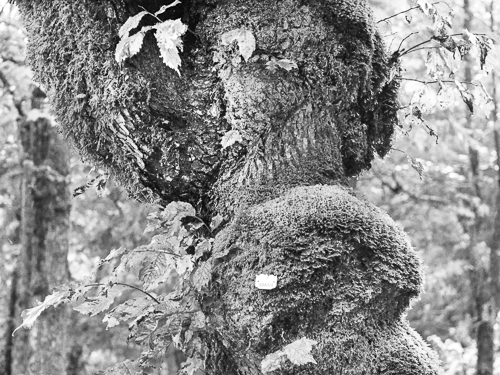Kulturlandskapssenteret arranged a free course in pollarding on Saturday 30 August at Myljom-To in Hjartdal. Being located in a fertile, but hilly terrain and stony ground, this area is poorly suited to modern agriculture and the cultural landscape still resembles more or less how it looked like in the late 1940s when mechanisation was introduced countrywide in Norway. Pollen analyses have shown that pollarding was in active use about 2500 B.C. and it has probably been kept in use until about 60 years ago. Then, farmers stopped doing it and meadows started disappearing and trees which had been pollarded for centuries were left in peace. However, for at least 4500 years, farmers used hay from meadows and dried leaves from pollarding to feed their animals throughout winter and early spring. Leaves from elm and ash were most sought after, but willow, rowan, aspen, alder, and birch were also used. Branches with green leaves were cut every 5 years and the leaves were dried in various ways. Yellow leaves had to be avoided meaning that pollarding had to be done in September at the latest.
Trees which have been pollarded regularly have bulky trunks with lots of strange shapes. They also consist of live, rotting, and dead wood, giving ideal conditions for many types of mushrooms, lichens, mosses, insects, birds, and bats. Lots of branches grow out where the tree has been cut and they are resistant to harsh weather and strong wind.
Fortunately, not all farmers have quit pollarding. Olav Tho, a farmer living in this area, has been doing pollarding for many years. Since all trees have a finite lifetime, it is necessary that new trees are pollarded. Since large areas in Hjartdal consist of of more or less steep meadows with trees which were pollarded in the past, it is possible to increase the number of trees by restoring those which were pollarded before. Having worked hard for many years, Olav Tho has cleared large areas around those trees. In fact, he told us that the first step in restoring a formerly pollarded tree is to let in light. When the tree receives light, it will also start growing branches which can be pollarded. However, when light is allowed to enter, lots of unwanted vegetation will also start appearing, meaning that he has to let both cattle and sheep graze at different times of the year in order to keep the landscape open. Besides, trunks and branches have to be removed requiring large amounts of work.
Next, the formerly pollarded trees also need to be restored, but there is not a tried-and-true way of doing it. The branches which have been growing freely for decades have to be removed somehow, and the cut has to be clean and oblique in order to let water escape. Apart from that, one never knows if restoring a tree will make it produce lots of leaves again or wither and die. Besides, branches may be rotten and this work can be dangerous.
After having learnt a little about pollarding, we went outside to a steep area called Myljom-To where there were lots of pollarded trees surrounded by meadows. After Olav had shown us some of them, he led us to a tree which he had pollarded in the morning. There he showed us how to make bundles of the branches by cutting them with a pollarding knife into manageable sizes before tying them together by means of bark taken from one of the branches. Finally, we were asked to make a couple of bundles ourselves. Having finished this task, Olav led us past some areas which he had cleared and restored some formerly pollarded trees. Obviously, there were lots of work for his sheep and cows to be done in order to keep the surrounding vegetation down.
We proceeded to another area called Ambjørndalen about 15 minutes walk away. Although we were near a road and not far from houses, the surrounding terrain was so hilly and overgrown that it felt like we were far from anyone. Like the area we had left, we were shown lots of pollarded trees , some which had been restored and some which would have to be restored later. They could be recognised by having large trunks up to some metres above ground, then more or less thick branches were growing from where the tree had been pollarded.
It was a pleasant experience in the rain, walking in a beautiful landscape, and watching how our ancestors used nature in order to survive.

